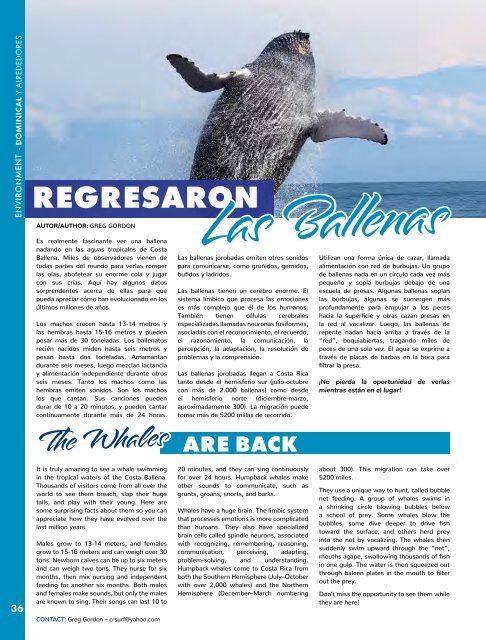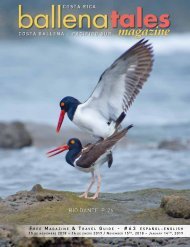South Pacific Costa Rica Travel Guide and Magazine #68
Visit the place where the forest meets the South Pacific Ocean in the Osa Canton. Visit Marino Ballena National Park the famous Whale’s Tail, with a length of about 2296 feet and a width of 820 feet, it is the world’s third-largest sandbank. During the low tide, you can walk to its very end. Ballena Tales is a Magazine & Travel Guide. Everything you need to know about Costa Ballena and Osa in the South Pacific of Costa Rica can be found here. From tides chart, discovering Local artists under Art & Culture to finding a Hotels in Osa, check out Tourism & Entertainment, we are here to lend you a hand. Discover the wonders of Costa Ballena and keep browsing to find all you’ll need to know about vacations in Costa Rica South Pacific Region.
Visit the place where the forest meets the South Pacific Ocean in the Osa Canton. Visit Marino Ballena National Park the famous Whale’s Tail, with a length of about 2296 feet and a width of 820 feet, it is the world’s third-largest sandbank. During the low tide, you can walk to its very end. Ballena Tales is a Magazine & Travel Guide. Everything you need to know about Costa Ballena and Osa in the South Pacific of Costa Rica can be found here. From tides chart, discovering Local artists under Art & Culture to finding a Hotels in Osa, check out Tourism & Entertainment, we are here to lend you a hand. Discover the wonders of Costa Ballena and keep browsing to find all you’ll need to know about vacations in Costa Rica South Pacific Region.
Create successful ePaper yourself
Turn your PDF publications into a flip-book with our unique Google optimized e-Paper software.
DOMINICAL Y ALREDEDORES<br />
ENVIRONMENT -<br />
REGRESARON<br />
AUTOR/AUTHOR: GREG GORDON<br />
Es realmente fascinante ver una ballena<br />
nad<strong>and</strong>o en las aguas tropicales de <strong>Costa</strong><br />
Ballena. Miles de observadores vienen de<br />
todas partes del mundo para verlas romper<br />
las olas, abofetear su enorme cola y jugar<br />
con sus crías. Aquí hay algunos datos<br />
sorprendentes acerca de ellas para que<br />
pueda apreciar cómo han evolucionado en los<br />
últimos millones de años.<br />
Los machos crecen hasta 13-14 metros y<br />
las hembras hasta 15-16 metros y pueden<br />
pesar más de 30 toneladas. Los ballenatos<br />
recién nacidos miden hasta seis metros y<br />
pesan hasta dos toneladas. Amamantan<br />
durante seis meses, luego mezclan lactancia<br />
y alimentación independiente durante otros<br />
seis meses. Tanto los machos como las<br />
hembras emiten sonidos. Son los machos<br />
los que cantan. Sus canciones pueden<br />
durar de 10 a 20 minutos, y pueden cantar<br />
continuamente durante más de 24 horas.<br />
The Whales<br />
Las Ballenas<br />
Las ballenas jorobadas emiten otros sonidos<br />
para comunicarse, como gruñidos, gemidos,<br />
bufidos y ladridos.<br />
Las ballenas tienen un cerebro enorme. El<br />
sistema límbico que procesa las emociones<br />
es más complejo que él de los humanos.<br />
También tienen células cerebrales<br />
especializadas llamadas neuronas fusiformes,<br />
asociadas con el reconocimiento, el recuerdo,<br />
el razonamiento, la comunicación, la<br />
percepción, la adaptación, la resolución de<br />
problemas y la comprensión.<br />
Las ballenas jorobadas llegan a <strong>Costa</strong> <strong>Rica</strong><br />
tanto desde el hemisferio sur (julio-octubre<br />
con más de 2.000 ballenas) como desde<br />
el hemisferio norte (diciembre-marzo,<br />
aproximadamente 300). La migración puede<br />
tomar más de 5200 millas de recorrido.<br />
ARE BACK<br />
Utilizan una forma única de cazar, llamada<br />
alimentación con red de burbujas. Un grupo<br />
de ballenas nada en un círculo cada vez más<br />
pequeño y sopla burbujas debajo de una<br />
escuela de presas. Algunas ballenas soplan<br />
las burbujas, algunas se sumergen más<br />
profundamente para empujar a los peces<br />
hacia la superficie y otras cazan presas en<br />
la red al vocalizar. Luego, las ballenas de<br />
repente nadan hacia arriba a través de la<br />
“red”, boquiabiertas, trag<strong>and</strong>o miles de<br />
peces de una sola vez. El agua se exprime a<br />
través de placas de barbas en la boca para<br />
filtrar la presa.<br />
¡No pierda la oportunidad de verlas<br />
mientras están en el lugar!<br />
36<br />
It is truly amazing to see a whale swimming<br />
in the tropical waters of the <strong>Costa</strong> Ballena.<br />
Thous<strong>and</strong>s of visitors come from all over the<br />
world to see them breach, slap their huge<br />
tails, <strong>and</strong> play with their young. Here are<br />
some surprising facts about them so you can<br />
appreciate how they have evolved over the<br />
last million years.<br />
Males grow to 13-14 meters, <strong>and</strong> females<br />
grow to 15-16 meters <strong>and</strong> can weigh over 30<br />
tons. Newborn calves can be up to six meters<br />
<strong>and</strong> can weigh two tons. They nurse for six<br />
months, then mix nursing <strong>and</strong> independent<br />
feeding for another six months. Both males<br />
<strong>and</strong> females make sounds, but only the males<br />
are known to sing. Their songs can last 10 to<br />
CONTACT: Greg Gordon – crsurf@yahoo.com<br />
20 minutes, <strong>and</strong> they can sing continuously<br />
for over 24 hours. Humpback whales make<br />
other sounds to communicate, such as<br />
grunts, groans, snorts, <strong>and</strong> barks.<br />
Whales have a huge brain. The limbic system<br />
that processes emotions is more complicated<br />
than humans. They also have specialized<br />
brain cells called spindle neurons, associated<br />
with recognizing, remembering, reasoning,<br />
communication, perceiving, adapting,<br />
problem-solving, <strong>and</strong> underst<strong>and</strong>ing.<br />
Humpback whales come to <strong>Costa</strong> <strong>Rica</strong> from<br />
both the <strong>South</strong>ern Hemisphere (July–October<br />
with over 2,000 whales) <strong>and</strong> the Northern<br />
Hemisphere (December–March numbering<br />
about 300). This migration can take over<br />
5200 miles.<br />
They use a unique way to hunt, called bubble<br />
net feeding. A group of whales swims in<br />
a shrinking circle blowing bubbles below<br />
a school of prey. Some whales blow the<br />
bubbles, some dive deeper to drive fish<br />
toward the surface, <strong>and</strong> others herd prey<br />
into the net by vocalizing. The whales then<br />
suddenly swim upward through the “net”,<br />
mouths agape, swallowing thous<strong>and</strong>s of fish<br />
in one gulp. The water is then squeezed out<br />
through baleen plates in the mouth to filter<br />
out the prey.<br />
Don’t miss the opportunity to see them while<br />
they are here!












